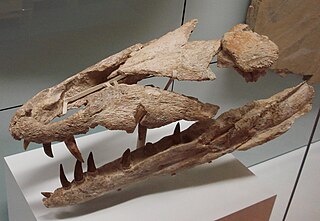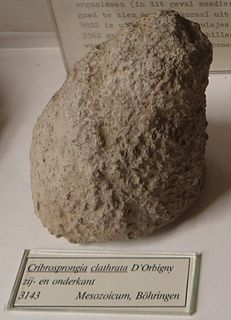
Alcide Charles Victor Marie Dessalines d'Orbigny was a French naturalist who made major contributions in many areas, including zoology, palaeontology, geology, archaeology and anthropology.
The Toarcian is, in the ICS' geologic timescale, an age and stage in the Early or Lower Jurassic. It spans the time between 182.7 Ma and 174.1 Ma. It follows the Pliensbachian and is followed by the Aalenian.
In the geologic timescale, the Bajocian is an age and stage in the Middle Jurassic. It lasted from approximately 170.3 Ma to around 168.3 Ma. The Bajocian Age succeeds the Aalenian Age and precedes the Bathonian Age.

Globigerina is a genus of planktonic Foraminifera, in the order of Rotaliida. It has populated the world's oceans since the Middle Jurassic.
In the geologic timescale, the Callovian is an age and stage in the Middle Jurassic, lasting between 166.1 ± 4.0 Ma and 163.5 ± 4.0 Ma. It is the last stage of the Middle Jurassic, following the Bathonian and preceding the Oxfordian.

In the geologic timescale, the Sinemurian is an age and stage in the Early or Lower Jurassic Epoch or Series. It spans the time between 199.3 ± 2 Ma and 190.8 ± 1.5 Ma. The Sinemurian is preceded by the Hettangian and is followed by the Pliensbachian.
In the geologic timescale, the Kimmeridgian is an age in the Late Jurassic Epoch and a stage in the Upper Jurassic Series. It spans the time between 157.3 ± 1.0 Ma and 152.1 ± 0.9 Ma. The Kimmeridgian follows the Oxfordian and precedes the Tithonian.

Dakosaurus is an extinct genus of crocodylomorph within the family Metriorhynchidae that lived during the Late Jurassic and Early Cretaceous. It was large, with teeth that were serrated and compressed lateromedially. The genus was established by Friedrich August von Quenstedt in 1856 for an isolated tooth named Geosaurus maximus by Theodor Plieninger in 1846. Dakosaurus was a carnivore that spent much, if not all, its life out at sea. The extent of its adaptation to a marine lifestyle means that it is most likely that it mated at sea, but since no eggs or nests have been discovered that have been referred to Dakosaurus, whether it gave birth to live young at sea like dolphins and ichthyosaurs or came ashore like turtles is not known. The name Dakosaurus means "biter lizard", and is derived from the Greek dakos ("biter") and σαῦρος -sauros ("lizard").

Heading requires correction, but Palaeocoma d'Orbigny, 1850, is an extinct genus of brittle stars that lived during the Middle Triassic to Early Jurassic Periods. Its fossils have been found in Europe.

Garantiana is a genus ammonite from the Bajocian stage at the beginning of the Middle Jurassic, included in the family Stephanoceratidae.

†Nerinea is an extinct genus of fossil sea snails, marine gastropod molluscs in the clade Heterobranchia.

Orthocormus is an extinct genus of prehistoric pachycormiform bony fish. It is known from three species found in Kimmeridgian aged plattenkalk deposits in Bavaria, Germany. The species "Hypsocormus" tenuirostris Woodward 1889 from the late Middle Jurassic (Callovian) Oxford Clay is not closely related to the type species of Hypsocormus, and is more closely related to Orthocormus + Protosphyraena, and thus has sometimes been referred to in open nomenclature as Orthocormus? tenuirostris.

Saurorhynchus is an extinct genus of carnivorous bony fish. It is the youngest representative of the family Saurichthyidae and the order Saurichthyiformes. This family is known for its large, elongate jaws, similar to modern Belonidae. Saurichthyidae also includes the Permian genus Eosaurichthys and the Triassic genus Saurichthys.

Opisthias is a genus of sphenodont reptile. The type species, Opisthias rarus, is known from the Late Jurassic Morrison Formation of western North America, present in stratigraphic zones 2 and 4–6. A lower jaw is also known from the Berriasian aged Lulworth Formation of the United Kingdom, which appears to be distinct from the type North American species. Other remains are also known from the Late Jurassic of Portugal. A fragmentary dentary possibly attributable to Opisthias is also known from the Berriasian aged Angeac-Charente bonebed in France.

Cuphosolenus is a genus of extinct small to medium-sized sea snails, marine gastropod mollusks in the family Aporrhaidae and the superfamily Stromboidea, known from the Jurassic and lower Cretaceous periods. Cuphosolenus was named by Edouard Piette in 1876.

Ophiopetra is a genus of prehistoric brittle stars. It lived in lagoons in Solnhofen Plattenkalk Formation. It has only one known species, Ophiopetra lithographica.

Harpagodes is an extinct genus of fossil sea snails, marine gastropod mollusks in the family Harpagodidae.

Protetragonites is an extinct genus of ammonoid cephalopods belonging to the family Lytoceratidae. These fast-moving nektonic carnivores lived from the Jurassic period Tithonian age to the Cretaceous period Aptian age.

Cuneolina is an extinct genus of prehistoric foraminifera in the family Cuneolinidae with species from the Jurassic and Cretaceous.

Cribrospongia is an extinct genus of prehistoric sponges in the family Cribrospongiidae. The species C. elegans is from the Jurassic period and has been found in Germany.
















